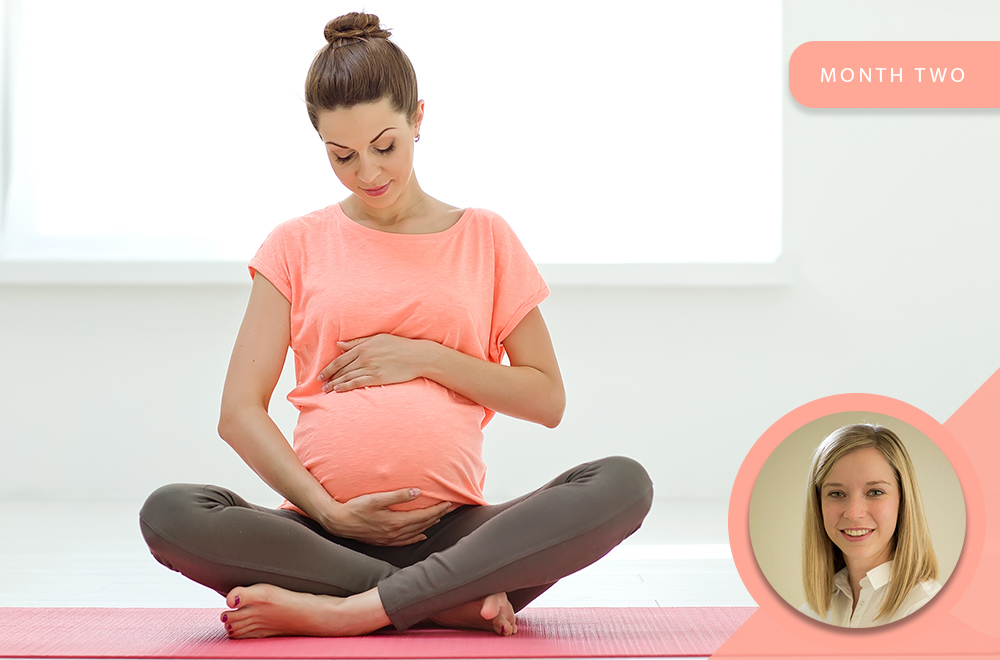
13 Jul Pregnancy: Month 2: A Physiotherapist’s Professional Opinion
As your pregnancy hormone levels continue to adjust nausea, vomiting and your sensitivity to specific foods will continue to increase. This is known by most people as the dreaded morning sickness. Fatigue and moodiness are likely to increase. This can leave you with lower energy levels as well as feeling lethargic and sluggish. Certain women may lose one or two kilograms during this month. We all expect to start gaining weight immediately during pregnancy, but it is normal to lose some weight initially if your morning sickness symptoms have been severe.
Between week six to eight estrogen causes breast tissue to start developing and grow. This will initially be more of an internal process and it might be difficult to detect a change in the size of your breasts straight away. Your breasts may, however, be sensitive to touch. Your nipples will start to protrude more as well as increasing in size. The veins on the surface of your breasts and chest will start to darken because of the effect that prostaglandin and estrogen has on the elasticity of your body’s blood vessels. Because of this, the veins will become more visible. Your skin may also take on a glowing appearance.
Women who were prone headaches before pregnancy might find that their headaches disappear. Non – headache sufferers may start experiencing headaches due to the change in hormone levels that cause the ligaments in your neck joints to loosen. This puts more strain on your neck muscles as they work harder to support the looser neck joints. These neck muscles tire more easily and as a result, tension-type headaches may develop.
Because you are feeling run down it is important that you listen to your body during this period. Take a midday nap if needed and if possible, try to do some form of cardiovascular exercise most days of the week. Let your body and energy levels guide you with regards to exercise. If your working environment allows you some flexibility you may want to consider breaking the day up into more manageable pieces with a small period of rest in between. If you suffer from depression and you feel like you have significantly lower energy levels than usual, please do consult with your attending doctor immediately.
Every woman is different and we all have varying fitness levels. The rule of thumb when it comes to exercise during pregnancy is to never attempt any extreme or new forms of exercise. You can continue your current sports activities in moderation. This means that you should exercise at a level that is currently comfortable and not necessarily at the levels you were performing at before pregnancy. Competitive athletes should be monitored and advised by their supervising gynaecologist as to the intensity of exercise they may partake in. If you were inactive to moderately inactive before falling pregnant it is advised to take up a light form of physical activity that includes a cardiovascular component such as walking on most, but preferably all days of the week for approximately 30 minutes. This is all assuming that your gynaecologist has given you permission to participate in physical activity. Cardiovascular exercise refers to an activity where your heart rate is at a safe, but higher level than your resting heart rate for the duration of the specific activity.
There are some exercises to avoid during pregnancy as they are harmful to your you and your unborn child. Heavyweight training, crunches and planks should be avoided. This can cause a condition called diastasis recti where your abdominal muscles separate. Participating in contact sports or sports where there is a higher risk of falling is not advised during pregnancy. Scuba diving should be avoided as it can cause defects in the fetus as well as causing decompression sickness.
EXERCISE OF THE MONTH: CHIN-TUCKS
1.Lie on your back, head on a small cushion or rolled up towel, shoulders relaxed and place your fist or a tennis ball between your chin and chest.
2.Gently tuck in your chin by performing a small nodding movement of the head on the neck to push down with your chin to hold the ball/fist in place.
3.Lift your head just off the pillow and hold for 5-10 seconds maintaining the pressure on the ball/fist.
4.As you lower your head, keep the ball/fist in place and only release this holding action once your head is resting back on the pillow.



Shirley Corcoran
Posted at 08:05h, 28 JulyHello Rooyen,
I am newly pregnant with my first baby. I have not enough ideas about pregnancy. That’s why I am always looking for a pregnancy-related post. This time I found you with helpful. And I will bookmark your site and keep follow this from now. If you had more insight, I would much appreciate it. Thanks for the sharing such an informative article.